‘Israel’s’ strikes on Baalbek and Tyre: A war on Lebanon’s identity
Israeli airstrikes on Lebanon are not just targeting civilian infrastructure but also attempting to erase Lebanon’s identity by striking dangerously close to UNESCO World Heritage sites, Baalbek and Tyre—icons of its rich cultural legacy.
-
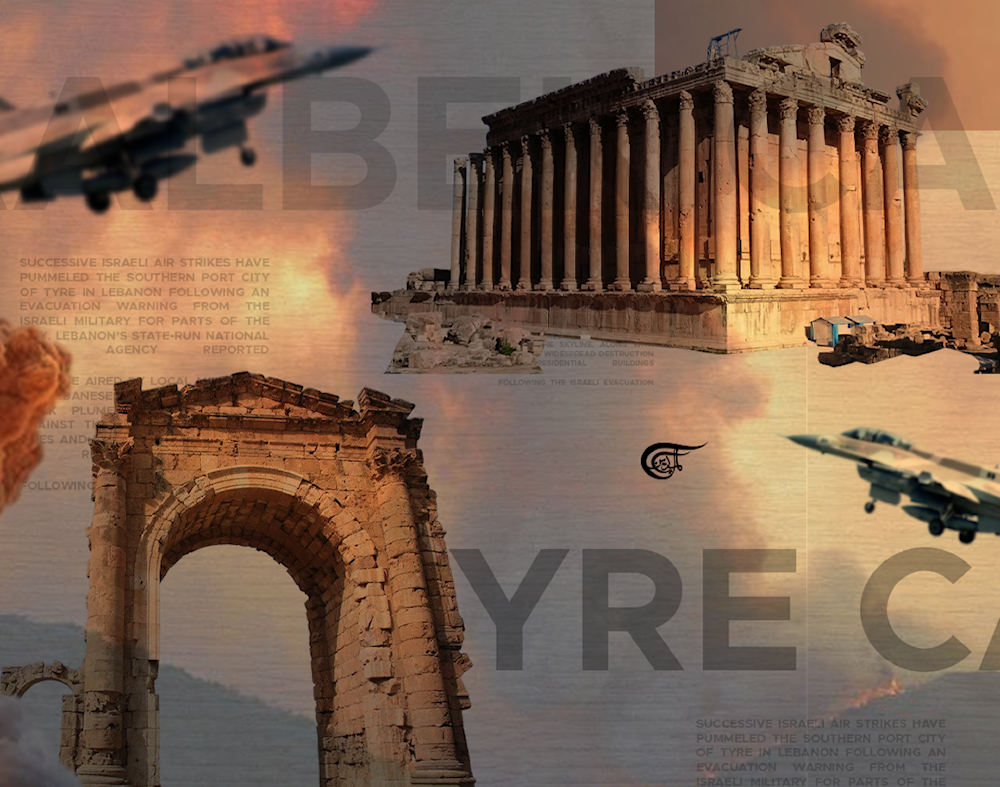
‘Israel’s’ strikes on Baalbek and Tyre: A war on Lebanon’s identity (Al Mayadeen English; Illustrated by Batoul Chamas)
The relentless Israeli airstrikes on Lebanon are not only destroying civilian infrastructure but also threatening two UNESCO World Heritage sites, Baalbek and Tyre, symbols of Lebanon’s millennia-old cultural identity. These strikes have put invaluable historical treasures at risk, with global heritage advocates sounding the alarm over the irreversible damage.
Under the guise of targeting Hezbollah-affiliated sites and ensuring the "safety" of the Lebanese people, Israeli occupation forces have been, at times, issuing "evacuation orders" for areas dangerously close to these cultural landmarks, drawing widespread condemnation from the Lebanese people and government, and cultural preservationists. Simply put, the Israeli occupation's assault on Baalbek and Tyre is an evident attack on Lebanon’s cultural identity, heritage, legacy, and the world's shared heritage.
-

In mid-October, the Israeli occupation military issued an "evacuation" order close to Tyre's historic landmarks. (Social media)
"Israel" has issued another so-called "evacuation order" to the residents of #Baalbek, #Douris, and #AinBourday, ordering them to move away from the #Zahleh-Baalbek Highway, Nahleh-Baalbek Road, and el-Arez-Baalbek Road.
— Al Mayadeen English (@MayadeenEnglish) October 30, 2024
Recently, "Israel" has unprecedentedly intensified its… pic.twitter.com/5mDfh9H2ci
Baalbek: The eternal city of the sun
-

Baalbek's ruins through the lens of Hussein Muo.
Nestled in eastern Lebanon, Baalbek stands as a symbol of Lebanon’s rich testament to human ingenuity and cultural synthesis over millennia. Known in antiquity as “Heliopolis” or “Always the City of the Sun,” Baalbek houses some of the finest examples of Phoenician ruins, Roman architecture, and Islamic monuments, earning its designation as a UNESCO World Heritage site in 1984.
For decades, Baalbek has hosted the renowned Baalbek International Festival during the summer, an annual celebration of music and arts that underscores its role as a cultural hub. The International Baalbek Festival has drawn global artists such as Fairuz, the Rahbani Brothers, Wadih el-Safi, Sabah, Warda al-Jazairia, Sting, Mika, Ella Fitzgerald, and Miles Davis, to perform in the mid of its stunning ancient backdrop, blending ancient history with contemporary artistry.
Baalbek’s historical mapping
Phoenician Ruins: Under the Roman Temples in Baalbek’s Castle, excavations have revealed the existence of ruins that date back to the Phoenicians, which are believed to have used the site as the Temple of Baal.
The Temple of Mercury: Known from coins of the Roman emperor Philip the Arab (r.244-249), only a staircase remains which is found at Sheikh Abdallah Hill, not far from the barracks of the Lebanese army.
-
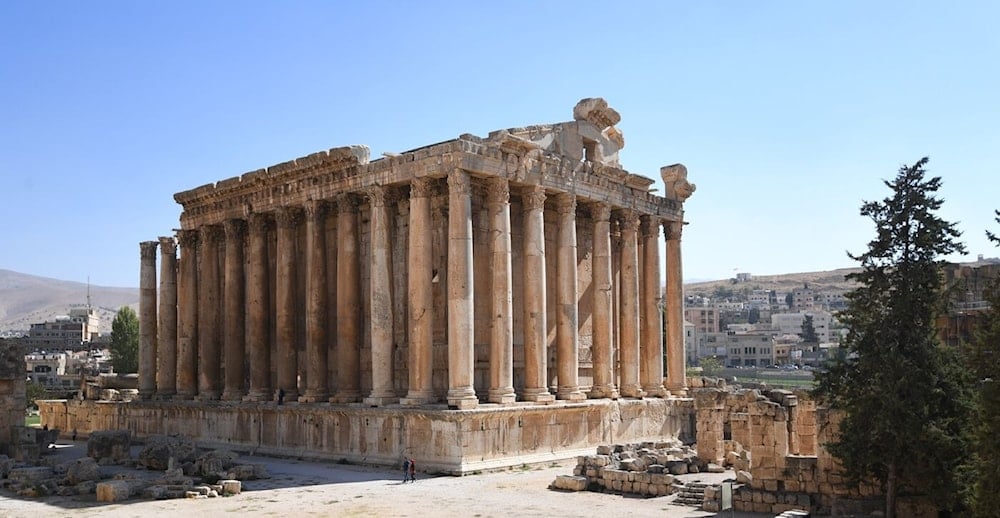
The Temple of Mercury. (Sputnik)
An old theater (Palmyra Hotel now): Its remains lie beneath the Palmyra Hotel, with a model on display found at the National Museum of Beirut.
Stone of the Pregnant Woman: This massive monolith, “Hajar Al-Hibla” or “Stone of the Pregnant Woman,” stands 20 meters high and 4.5 meters wide and is one of the largest stones ever cut by humans.
-
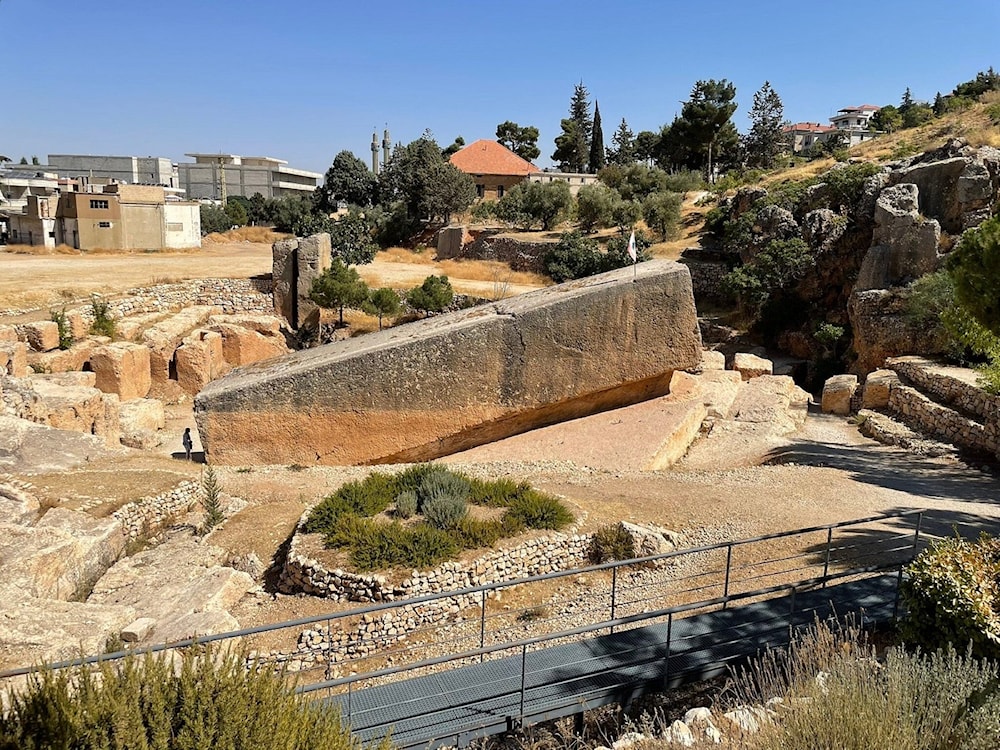
Stone of the Pregnant Woman. (Trip Advisor)
Ras al-Imam al-Hussein Mosque: The mosque was built during the Mamluk period in honor of Imam Hussein, the grandson of Prophet Mohammad (PBUH).
-
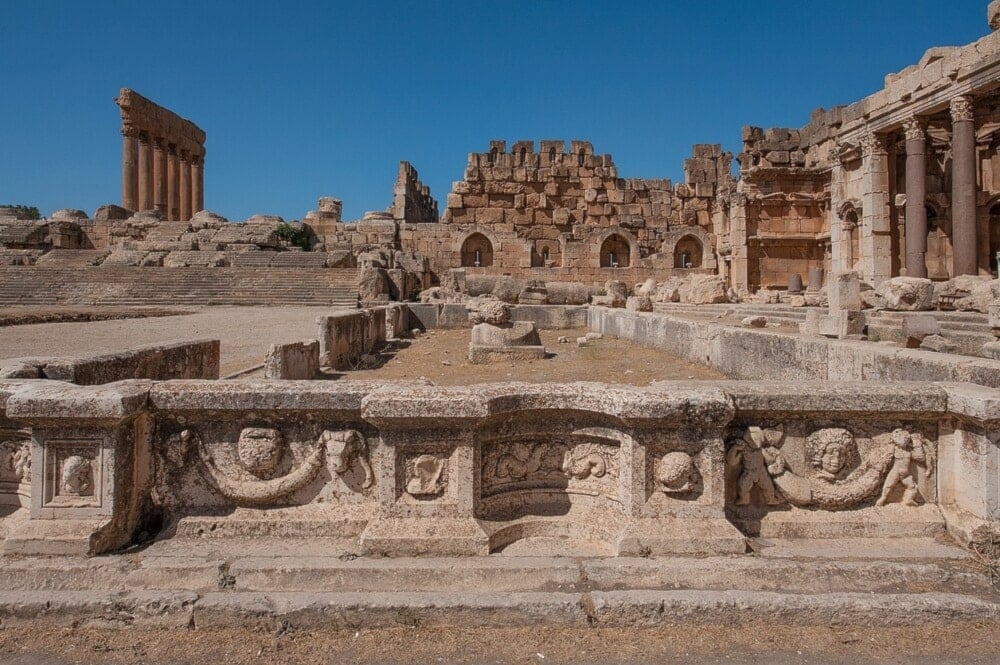
Baalbek ruins. (UNESCO/ Ko Hon Chiu Vincent)
The Great Umayyad Mosque: Situated near the entrance to Baalbek's Roman archaeological site, this 7th–8th-century mosque was constructed on the Roman forum, which had previously been converted into the St. John Byzantine Church in the 4th–5th centuries. It features granite and limestone columns and underwent restoration in the 1990s.
Bustan al-Khan: A Roman bath in the southwestern part of the ancient city, presumably built in the late second century A.D., notable for its banquet hall and urban prominence and covers an area of nearly 10,000 square meters.
Saint Barbara Cathedral: Built during the Byzantine Period, it is the seat of the Greek Melkite Catholic Archeparchy of Baalbek.
Qubat Douris: A shrine that most likely dates to the Ayyubid Period had a dome above eight columns of red granite and is located on the left of Baalbek’s southern entrance.
-

Qubat Duris. (Lebanon Untravelled)
Baalbek Roman Temples:
- The Hexagonal Forecourt: A six-sided area with 30 granite columns from the 3rd century A.D, built between the Propylaea and the Great Court, which was later converted to a church by the 5th
- The Temple of Jupiter (15-55 A.D.): It is the greatest temple of Baalbek, and its shrine was the largest sanctuary in the Roman world. Today, only six Corinthian columns on the south side, carrying their entablature, remain.
- The Temple of Bacchus (60-150 A.D.): An exceptionally well-preserved temple, larger than the Parthenon in Athens, which boasts an interior span of 62 feet and a monumental gateway measuring 21 feet in width and nearly 42 feet high.
- The Temple of Venus: A small, circular temple with six columns that likely supported a dome. Its surface is intricately adorned with niches, elegant carvings, and decorations, though the sculptures have been lost over time.
Baalbek today: Threatened by ‘Israel’s’ indiscriminate strikes
This ancient city of crossroads of civilizations, that embodied a blend of Phoenician, Greek, Roman, and Islamic heritage, now lies in peril.
View this post on Instagram
In early November, an Israeli airstrike destroyed a historic building in the Manshiyeh neighborhood, which dates to the Ottoman era and lies within arm’s reach of the UNESCO-listed temples of Baalbek in eastern Lebanon.
The Governor of Baalbek and Hermel, Bachir Khodr, told Reuters that the neighborhood "is a very artisanal neighborhood, typically full of tourists," adding that no one was in the targeted building.
While there was no immediate visible damage to the temple complex, as confirmed by the castle guards, Khodr said, "We need experts - engineers and archaeologists - to come look. No one has been able to do so yet because of the strikes."
Meanwhile, Maya Halabi of the Baalbek International Festival said that a total of three Ottoman-era sites were recently damaged by Israeli airstrikes, including the Gouraud Barracks and the Palmyra Hotel.
"The Acropolis - where the temples are - is just a few meters away. They haven't been damaged yet and we hope that won't happen," Halabi told Reuters.
#AlMayadeen’s correspondent Mouhamad Sahili reported from Ras al-Ayn, Baalbek, where Israeli airstrikes have wreaked havoc on the city’s cultural and economic sites.
— Al Mayadeen English (@MayadeenEnglish) November 3, 2024
Known for its cafes, restaurants, and heritage landmarks, Ras al-Ayn is a popular spot for tourists near the… pic.twitter.com/hlP89plqOu
Tyre: The maritime jewel of Phoenicia
-
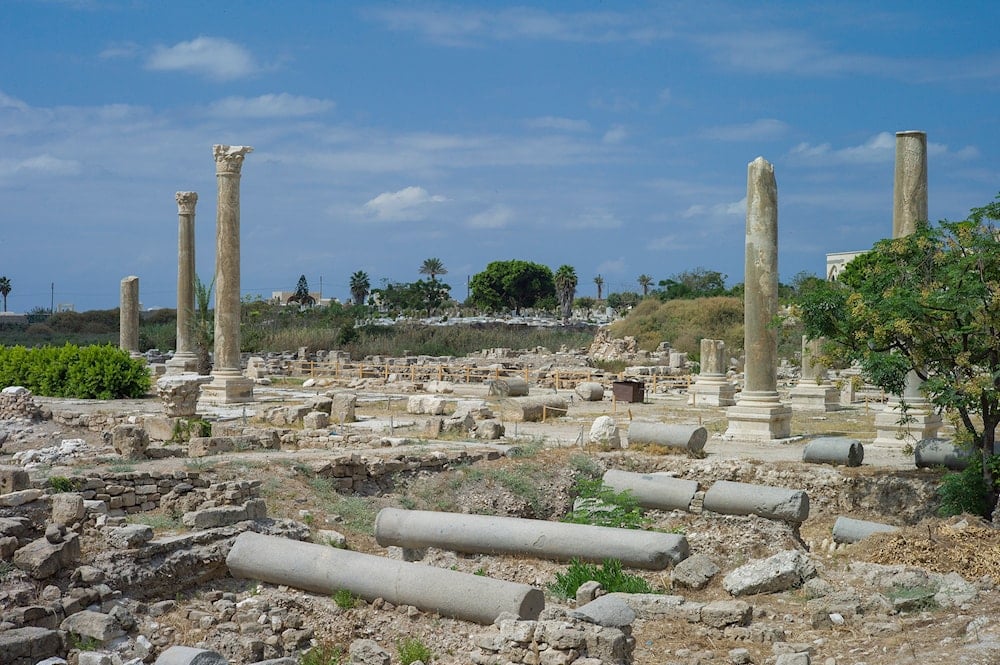
Tyre ruins. (UNESCO/ Ko Hon Chiu Vincent)
To the South of Lebanon, Tyre stands to tell the tales of the ingenuity and legacy of all those who inhabited it.
Designated as a UNESCO World Heritage site in 1984, Tyre was the great Phoenician city that reigned over the seas with its maritime trade and founded prosperous colonies such as Cadiz and Carthage. Legend has it that the city is the place where purple pigment was first created. Tyrian purple dye was crushed out of Murex shells to embroider royal robes.
A legacy of innovations and trove of ancient history:
Tyre, one of the world’s oldest cities, has witnessed and withstood the rise and fall of empires for nearly 5,000 years. Its ruins stand as testaments to humanity's earliest advancements with its priceless historic sites and heritage.
Take the Roman Hippodrome, built in the first century A.D., once holding 40,000 spectators for chariot races and Olympic Games activities, like races and pentathlons, where you can almost hear the echo of chariot wheels and cheering crowds from two millennia ago. This second largest and best-preserved of its kind had a marketplace that thrived beneath the Hippodrome seating area.
-

Seats of the circus, Hippodrome. (UNESCO/ Tim Schnarr) -
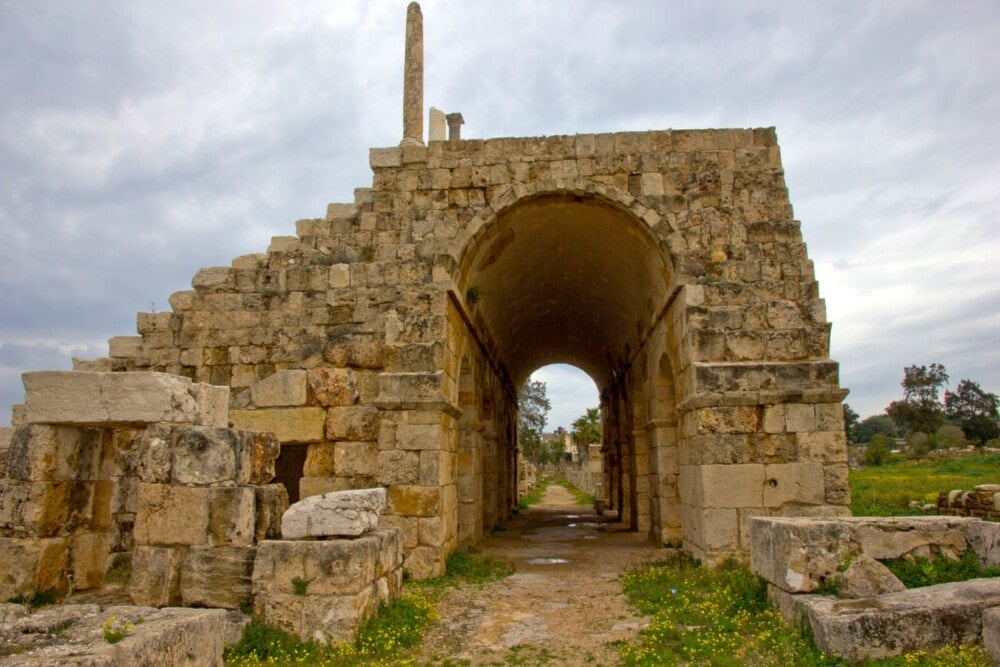
Possibly the marketplace beneath the Hippodrome. (UNESCO/ Tim Schnarr)
The Arch of Victory, constructed in the second century A.D. most likely under Emperor Hadrian, soars 21 meters high. Its northern tower floor was covered with mosaics, while the southern tower’s floor was paved with stone. Its adjacent Roman Road, dating to the first century and running from the monumental gate to the west, still bears chariot wheel marks etched into its flagstones.
-

The Arch of Victory. (UNESCO/ Tim Schnarr)
The Roman Baths, dating to the second and third centuries A.D., were built with arcades to counteract sea humidity and underground water. Behind the baths were the heating rooms that supplied the building with hot water. Today, the marble floors and walls are gone, but they live on.
Umm Al-Amad, located on a hill close to the sea with temples that overlook the sea and the port, the site still contains the remains of two important temples, as well as other buildings, dating back to the second century and third century B.C., and represents the last of the Phoenician culture under the rule of the Greeks. Several steles bearing Phoenician inscriptions were discovered on the site, as well as an important sundial stone.
Modern-day Tyre is divided into two main areas: the town on the headland and the El Bass Necropolis on the mainland. The town features significant archaeological remains, a great part of which is submerged. The most noteworthy structures include the Roman baths, two palaestra, an arena, the Roman colonnaded road, a residential quarter, and the remains of the 12th-century Venetian-built cathedral. Also notable are parts of the ancient Crusader castle walls. El Bass, once the town’s main gateway, showcases a necropolis flanking a grand Roman causeway crowned by a 2nd-century triumphal arch. This area also houses a Roman aqueduct and the vast hippodrome.
Tyre today: Endangered by ‘Israel’s’ indiscriminate raids
While a Protection and Enhancement Plan is being prepared according to UNESCO, it is protected by the Antiquities Law No. 166/1933, and the Law on Protection of Cultural Property, No 37/2008. The conservation and management of the property is assured by the Directorate General of Antiquities (DGA), according to UNESCO.
Despite that, “Israel” has shown utmost disregard and disrespect for the law, as it has been issuing “evacuation” orders and striking the city and near Tyre’s Roman ruins, including the Necropolis and Hippodrome. Israeli strikes have been pounding the city as black smoke plagues the areas, including from those on the seafront near the ruins.
At around 6:30 pm on Friday, Israeli occupation forces renewed airstrikes on #Tyre in southern #Lebanon, targeting two buildings—one on Safieddine Street and the other in Kamal Jumblatt Square in the city's inner neighborhoods, according to eyewitnesses.
— Al Mayadeen English (@MayadeenEnglish) November 9, 2024
Footage from the site… pic.twitter.com/XBDN9xqsva
Cultural genocide: Lebanon’s identity under attack
“Israel’s” indiscriminate strikes on Baalbek and Tyre are nothing short of war crimes that transcend physical destruction. Such crimes are an attempt to erase the very identity of Lebanon and its cultural memory.
These UNESCO-protected sites that Lebanon has long been famed for, long before the Israeli occupation, represent millennia of history, and embody the art, resilience, innovation, and legacy of Lebanon's ancestors, making them vital not just to the Lebanese people but to global heritage.
By attempting to sever Lebanon’s connection to its past, these Israeli airstrikes aim to erase the very identity of a nation that has long been a cradle of civilization.
In response, Lebanese officials, along with hundreds of cultural experts, such as archaeologists and scholars, urged the United Nations to protect Lebanon's cultural heritage in a petition released on November 17, a day before a special session in Paris, which aims to list Lebanese cultural sites under "enhanced protection."
The petition called on UNESCO to safeguard Baalbek and other cultural sites by creating "no-target zones" around them, deploying international observers, and implementing protections outlined in the 1954 Hague Convention on cultural heritage during armed conflict.
The petition clearly stated that "Lebanon's cultural heritage at large is being endangered by recurrent assaults on ancient cities such as Baalbek, Tyre and Anjar, all UNESCO world heritage sites, as well as on other historic landmarks.” It also urged powerful nations to advocate for a halt to attacks that harm cultural sites and to either implement additional protections or impose sanctions to prevent further destruction.
The plea was heard, as on November 18, UNESCO granted "provisional enhanced protection" to dozens of heritage sites in Lebanon, providing them with stronger legal safeguards as the brutal Israeli aggression continues. 34 cultural properties now benefit from "the highest level of immunity against attack and use for military purposes," according to a statement released by the United Nations cultural body.
UNESCO said this decision "helps send a signal to the entire international community of the urgent need to protect these sites." It further emphasized that "non-compliance with these clauses would constitute 'serious violations' of the 1954 Hague Convention and... potential grounds for prosecution."
Baalbek and Tyre "will receive technical and financial assistance from UNESCO to reinforce their legal protections, improve risk anticipation and management measures, and provide further training for site managers," the organization stated.

 11 Min Read
11 Min Read








